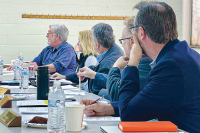Blemishes uncovered
Winter is unsparing. It exposes the lines and blemishes on human faces. It reveals worn hillsides and rutted backcountry lanes. It clarifies the ongoing, relentless processes of nature of which we are but a part.
In winter, the bare trunks of trees become apparent. Like an old man’s face, mature hardwood trunks are covered with blemishes that signify age: cankers, seams, burls, butt scars, sterile conks, and protrusions in the form of bracket fungi. Winter is the time to take a closer look at this somber side of the natural world.
Cankers are tree diseases via which lesions caused by a wide range of fungi and bacteria appear on trunks and branches. When the infected tissue dies, the lesions then crack and split open, exposing underlying tissues to further infection.
Some cankers grow on a perennial basis, forming concentric rings in trunk bark with each cycle of growth. Because of these patterns, cankers of this sort are sometimes referred to as “target cankers.” Other cankers — like the one now killing off the butternut tree here in the Smokies region — eat through the trunk bark exposing darkened elliptical patches of the outer cambium.
Seams are long vertical or spiral cracks on tree trunks. They vary in size from a few inches to a few feet to the entire length of the trunk. These are usually caused by wind, lightning, or frost and occur in all trees species. They are, however, observed most frequently on the bark of beech trees because of its smooth thin bark. Sometimes a seam will fold inward, forming a smooth turning pattern like a carefully tucked blanket.
Related Items
Burls or galls are round to semi-round or elongate swellings of the trunk. They range in size from a few inches to several feet in width. Fantastically shaped burls on birch trees in the higher elevations of the mountains lend an eerie touch to that often fog-shrouded landscape.
For a period during World War II — when the European woods traditionally used to make briar pipes were not available — underground burls on the roots of laurel and rhododendron in boggy places were harvested here in the southern mountains as a substitute. The center of that industry was located around Hendersonville and Brevard, where bogs then abounded. Another spot was the White Oak Stamp in Clay County. An old road near Chunky Gal Mountain is still known as “the old burl road.”
The most interesting, for me, of the growth forms under discussion here are the various bracket fungi that become especially apparent during the winter months. Some are shaped like a horse’s hoof, others like a turkey’s tail. Some are as large as dinner platters, others as small as your fingernail. Also known as pore fungi, bracket fungi belong to a mushroom family (Polyporaceae) whose members grow attached to decomposing logs and tree trunks.
My favorites among the bracket fungi are the birch brackets (Polyporus betulinus) and the artist’s conk (Ganoderma applanatum). As their common name indicates, birch brackets grow only on birch, forming smooth-surfaced, downward-hanging fruiting bodies that one writer described as “looking like a thick puffed-up pancake on top.” Visit the Joyce Kilmer Wilderness Area in winter and you’ll have little trouble spotting bouquets of birch brackets.
The bracket fungi known as artist’s conk can grow to more than two feet in diameter. They are found solitary or in groups, growing on hardwood stumps and logs as well as from wounds in living trees. They are not species specific and may appear on almost any hardwood or conifer species.
These cracked, furrowed, knobby growths are really hard. Often you have to use some kind of tool to prize then off a tree trunk. Larger specimens have been made into stools.
In Mushrooms Demystified (1986), mycologist David Arora calculated that a large artist’s conk (he found one monster weighing in at 26 pounds) “liberates 30-billion spores a day, 6 months a year — or over 5,000,000,000,000 (5 trillion!) spores annually.” Since the white pore surface on the underside of the bracket bruises easily and stains permanently brown when scratched, they have also been used to leave messages in the woods or as a means for making sketches. Messages scrawled on the undersides of artist’s conk brackets have sometimes been left alongside the Appalachian Trail to advise stragglers of their hiking partner’s whereabouts or condition.
George Ellison wrote the biographical introductions for the reissues of two Appalachian classics: Horace Kephart’s Our Southern Highlanders and James Mooney’s History, Myths, and Sacred Formulas of the Cherokees. In June 2005, a selection of his Back Then columns was published by The History Press in Charleston as Mountain Passages: Natural and Cultural History of Western North Carolina and the Great Smoky Mountains. Readers can contact him at P.O. Box 1262, Bryson City, N.C., 28713, or at This email address is being protected from spambots. You need JavaScript enabled to view it..









